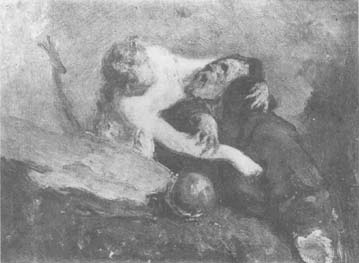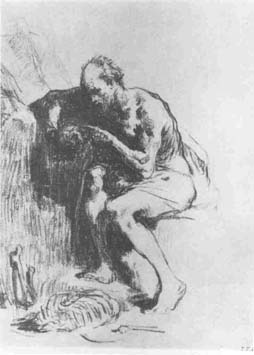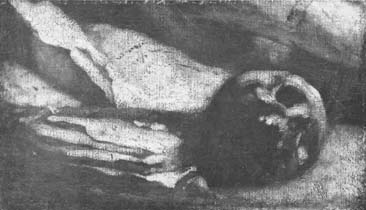
Bulletin 24, 1974
Home
Français
Introduction
History
Annual Index
Author &
Subject
Credits
Contact




Millet's
"Saint Jerome Tempted" and
"Oedipus Taken Down from the Tree":
The Discovery of
a Lost Painting
by Bruce Laughton
Pages 1 | 2
| 3
| 4
| 5
| 6
Unfortunately, it is most unlikely that Sensier had ever seen the picture. He first met Millet early in 1847, by which
time the Oedipus would have been under way. What Sensier did possess
was an oil sketch of the Temptation of Saint Anthony (fig.
3), in which the two figures closely resemble the arrangement of those
visible in the Ottawa X-ray. For the implication of a number of
women tempting the saint, he is more likely relying upon the iconography
of Saint Jerome as indicated in Christian literature, and in certain
pictorial precedents. Indeed, as this iconography would certainly have
been familiar to Millet himself, (6) the artist may have unwittingly been
the source of Sensier's imaginary description of the picture, through his
conversation alone.
Saint Jerome, born A.D. 347 at Stridon, studied in Rome, was
baptised in 366, and made a pilgrimage to the Holy Land in 373. During
A.D. 373-375 he was in the Syrian Desert as an Anchorite, where he wrote
the Life of Saint Paul the Hermit. Paintings by Veronese (Aynhoe
Park, Northants, England), Domenichino (fresco in St. Onofrio, Rome), Zurbaran
(for the Hieronymites of Guadalupe, 1638), and Valdés Léal
(for the Hieronymites of Santiponce, 1657, Seville Museum) create the type
known as 'the temptation in the desert of Syria.' They all have in common
a group of young women dancing in front of the saint who is struggling
with his libido. Another early variant is a Temptation of Saint Jerome
by Vasari (Graetz coll., Castello Vincigliata), where the saint is
menaced by Venus with doves and cupids, one shooting arrows, while he contemplates
a skull and a crucifix. (7)
The theme, so analogous to the carnal temptations of Saint Anthony
Abbot (born A.D. 251), arises from an autobiographical account of
Saint Jerome in which he recounts his tribulations: "(alone in the scorching
desert)...my imagination plunged me into the riotous dancing of young
Roman women." (8) The motif was ignored in the Middle Ages and only appeared
in Spanish and Italian Mannerist and Baroque painting. This seems to be
significant in terms of the style in which Millet himself rendered the
subject, although his composition will be seen not to relate to the examples
cited (whereas Sensier's description makes it sound as though it did).
The type of head with which Millet chooses to depict Saint Jerome
as revealed in the X-ray (fig. 2) certainly seems to relate to a Baroque
style (compare for example the head of the Saint in Guido Reni's Saint
Jerome Compiling the Vulgate, now in the Vienna Picture Gallery).
On the other hand, Dr Robert Herbert suggests a source in nineteenth-century
treatises on expression, usually derived from antique sculpture associated with Skopas and his
followers. (9) In any case the high bald forehead
relates closely to Millet's sanguine drawing called Saint Jerome Reading
(fig. 4), which must surely be contemporary with the painting. (10) The
upper half of the naked lady revealed in the X-ray has a distinctly
Venetian look. Although she is evidently grasping the saint by the scruff
of the neck, her pose and the angle of her head suggests a more sophisticated
caress.
The question remains, what did Millet's whole composition look
like? Without the discovery of a preparatory drawing or composition
study, we are left with only four pieces of evidence: (a) the oil sketch
of Saint Anthony owned by Sensier, which shows only two figures;
(b) the dimensions of the Ottawa canvas; (c) a surviving fragment referred
to by Sensier as "the bottom part, where one finds, more or less modified,
a skull and some attributes of the saint" (11): this is identifiable with
the painting Still Life with a skull now owned by Mrs Meyer-Huber
and reproduced here (fig. 5); and (d) the probable dimensions of the painting
submitted to the Salon jury.
In the Enregistrement des Ouvrages for the Salon of 1846
Millet's entry (nr. 4255) is listed as "I (tableau) tentation, hauteur
1.50 largeur I.60.X" (rejected). (12) The dimensions given are those of the
frame, apparently approaching a square shape. For an idea of how the frame
could relate to the size of the canvas, we can compare the entry for the
Oedipus, accepted in 1847: "hauteur 1.60 largeur 1.20." The original
long dimension of the Oedipus canvas measured approximately 133.5
cm (52-9/16 in.). Therefore the frame itself would appear to be slightly
under 13.5 cm wide (about 5-1/4 in.), give or take a little for overlapping
(see scale diagram, fig. 6). In so far as the lateral dimension of the
Saint Jerome frame accords exactly with the vertical dimensions
of the Oedipus frame, and given that the right vertical edge of
the Oedipus canvas is the only one cut down after the original composition was
painted (13) it is thus demonstrated that Ottawa possesses
the whole upper part of Saint Jerome. Roth frames must have been
the same width.
We can now begin to reconstruct the possible appearance of
the original composition. This has been attempted in the accompanying diagram
and sketch (fig. 6). Given the position and size of the two visible heads,
there would appear to be scarcely room for more than two figures, although
there remains the possibility of additional temptresses adumbrated in the
murk above the principal participants. (14) The balance of probability,
however, seems to point to a composition very close to that of Sensier's
oil sketch of Saint Anthony, notwithstanding that Saint Anthony's
cowl has been removed and his personality changed into that of Saint Jerome.
In the other fragment, Mrs Meyer-Huber's Still Life with a Skull,
one can see in the original not only the arm but also the side of the
torso of the woman. (15) Allowing for a few centimetres being taken off both
canvases to allow for re-stretching, the position of the Meyer-Huber painting in the original composition may be reasonably guessed at as the lower
left hand corner. This would make the woman's body correspond to the arrangement in Sensier's sketch, in which the prominent motif of the skull also
occurs. The proportions of the sketch are not the same as those of the
big picture, (16) and when the two are compared, it is evident that Millet
changed the design somewhat to allow more space above the heads of the
figures, and moved the position of the skull. What appears to be a tree-trunk
in the sketch becomes papers with writing on them in the 'still life.'
(Note that Sensier described this as "more or less modified" after the
Saint Jerome was cut up.) The exact position of the Meyer-Huber
canvas in the original composition of course cannot be proved, and the
lower right hand quarter remains missing. The drawn reconstruction given
here is thus a little fanciful, but it is based on proportionate measurements and attempts to show what Millet had in mind. (Readers may prefer
to try drawing it themselves!)
Saint Jerome Tempted is plainly an erotic subject, whatever Sensier imagined
was happening when Millet was actually "pinceau à la main." It is
also compounded with conflicts. The young woman and the old saint, the
artist's extramarital bliss shadowed by the formidable
figure of his pious grandmother, his desire to impress, even to astound,
the Salonjury, and the rejection of his labour (perhaps not worthy of eternity?): all these factors point to a disturbed and disoriented phase in Millet's
career. This painting's replacement by the Oedipus in 1847 is also
an interesting story.
Next Page | infant Oedipus
1 |
2 | 3
| 4
| 5
| 6
Annual Index | Author & Subject | Credits | Contact
This digital collection
was produced under contract to Canada's Digital Collections program,
Industry Canada.
"Digital
Collections Program, Copyright
© National Gallery of
Canada 2001"